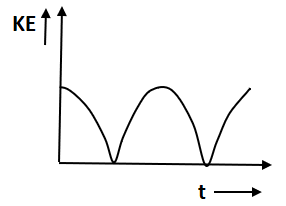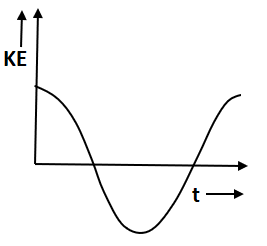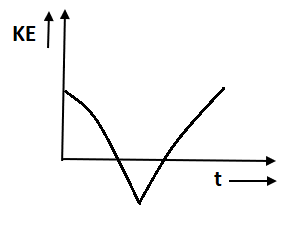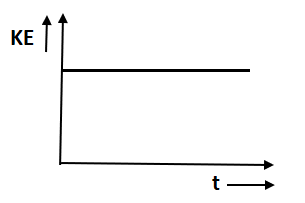
A body performs S.H.M. Its kinetic energy KE varies with time t as indicated by graph
A. 
B. 
C. 
D. 
Answer
223.8k+ views
Hint: In a simple harmonic motion (SHM) the distance of positive extreme position and negative extreme position from the mean position is represented as an amplitude(A). At extreme position velocity will be maximum and thus kinetic energy (KE) will also be maximum. By using this we can draw a graph between kinetic energy (KE) and time (t).
Formula used:
The kinetic energy (KE) of a body is given as,
\[KE = \dfrac{1}{2}m{v^2}\]
Where m is the mass and v is the velocity.
simple harmonic motion (SHM), the velocity is given as,
\[v = A\omega \cos (\omega t + \phi )\]
Where A is the amplitude, \[\omega \] is the angular frequency, t is the time taken and \[\phi \] is the phase constant.
Complete step by step solution:
As we know that the kinetic energy (KE) of a body is,
\[KE = \dfrac{1}{2}m{v^2}\]
For a body performing simple harmonic motion (SHM), the velocity is given as.
\[v = A\omega \cos (\omega t + \phi )\]
Therefore, we have;
\[KE = \dfrac{1}{2}m{A^2}{\omega ^2}{\cos ^2}(\omega t + \phi )\]
This gives kinetic energy that will always be positive. Thus, option B and C which represent negative kinetic energy violate the condition so cannot be the answer. Option D which represents constant kinetic energy also violates the condition. Option A represents the positive kinetic energy.
Hence option A is the correct answer.
Note: The kinetic energy is defined as the energy which is possessed by a body when it is in the state of motion. The energy in the simple harmonic motion (SHM) is shared between elastic potential energy (PE) and kinetic energy (KE). The energy of a particle oscillating in SHM depends on the mass of the particle, frequency and amplitude of oscillation.
Formula used:
The kinetic energy (KE) of a body is given as,
\[KE = \dfrac{1}{2}m{v^2}\]
Where m is the mass and v is the velocity.
simple harmonic motion (SHM), the velocity is given as,
\[v = A\omega \cos (\omega t + \phi )\]
Where A is the amplitude, \[\omega \] is the angular frequency, t is the time taken and \[\phi \] is the phase constant.
Complete step by step solution:
As we know that the kinetic energy (KE) of a body is,
\[KE = \dfrac{1}{2}m{v^2}\]
For a body performing simple harmonic motion (SHM), the velocity is given as.
\[v = A\omega \cos (\omega t + \phi )\]
Therefore, we have;
\[KE = \dfrac{1}{2}m{A^2}{\omega ^2}{\cos ^2}(\omega t + \phi )\]
This gives kinetic energy that will always be positive. Thus, option B and C which represent negative kinetic energy violate the condition so cannot be the answer. Option D which represents constant kinetic energy also violates the condition. Option A represents the positive kinetic energy.
Hence option A is the correct answer.
Note: The kinetic energy is defined as the energy which is possessed by a body when it is in the state of motion. The energy in the simple harmonic motion (SHM) is shared between elastic potential energy (PE) and kinetic energy (KE). The energy of a particle oscillating in SHM depends on the mass of the particle, frequency and amplitude of oscillation.
Recently Updated Pages
JEE Isolation, Preparation and Properties of Non-metals Important Concepts and Tips for Exam Preparation

Isoelectronic Definition in Chemistry: Meaning, Examples & Trends

Ionisation Energy and Ionisation Potential Explained

Iodoform Reactions - Important Concepts and Tips for JEE

Introduction to Dimensions: Understanding the Basics

Instantaneous Velocity Explained: Formula, Examples & Graphs

Trending doubts
JEE Main 2026: City Intimation Slip Releasing Today, Application Form Closed, Exam Dates, Syllabus & Eligibility

JEE Main 2026 Application Login: Direct Link, Registration, Form Fill, and Steps

Understanding the Angle of Deviation in a Prism

How to Convert a Galvanometer into an Ammeter or Voltmeter

Ideal and Non-Ideal Solutions Explained for Class 12 Chemistry

Hybridisation in Chemistry – Concept, Types & Applications

Other Pages
JEE Advanced Marks vs Ranks 2025: Understanding Category-wise Qualifying Marks and Previous Year Cut-offs

Laws of Motion Class 11 Physics Chapter 4 CBSE Notes - 2025-26

Mechanical Properties of Fluids Class 11 Physics Chapter 9 CBSE Notes - 2025-26

Units And Measurements Class 11 Physics Chapter 1 CBSE Notes - 2025-26

JEE Advanced 2026 - Exam Date (Released), Syllabus, Registration, Eligibility, Preparation, and More

JEE Advanced 2026 - Exam Date (Released), Syllabus, Registration, Eligibility, Preparation, and More




